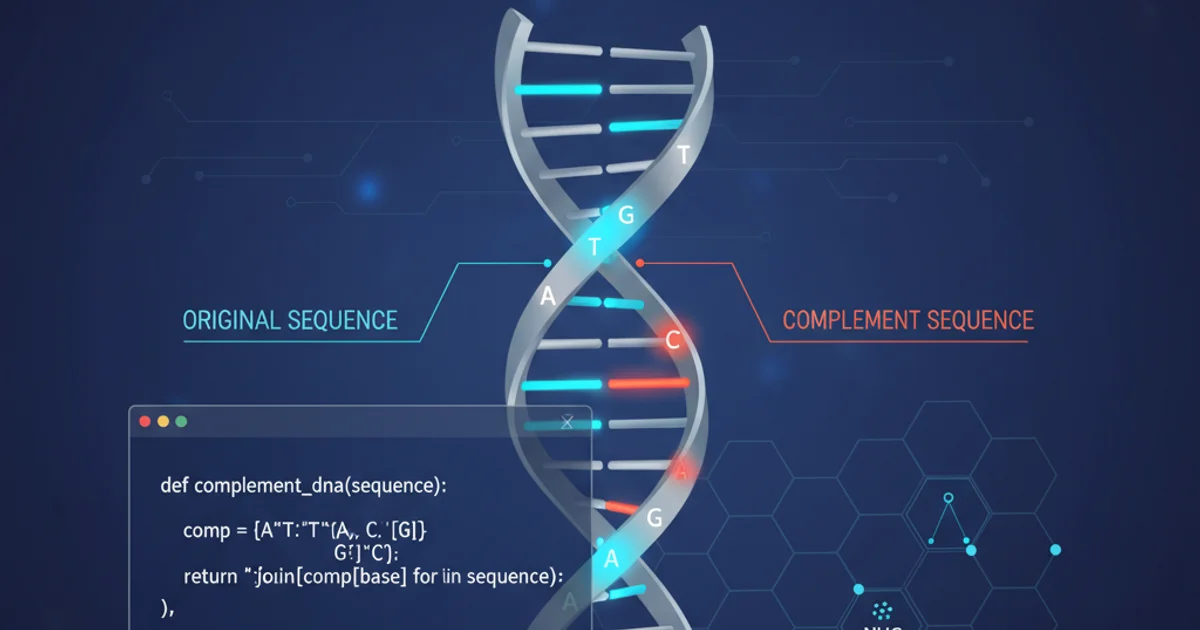Complement a DNA sequence
Categories:
Complementing DNA Sequences in R: A Comprehensive Guide

Learn how to accurately complement DNA sequences in R, covering basic principles, common challenges, and robust solutions for bioinformatics tasks.
In bioinformatics, manipulating DNA sequences is a fundamental task. One common operation is complementing a DNA sequence, which involves replacing each nucleotide with its complementary base (A with T, T with A, C with G, G with C). This process is crucial for various analyses, including primer design, sequence alignment, and understanding gene regulation. This article will guide you through different methods to complement DNA sequences in R, addressing common pitfalls and providing efficient solutions.
Understanding DNA Complementarity
DNA is a double helix structure where two strands are held together by hydrogen bonds between complementary base pairs. Adenine (A) always pairs with Thymine (T), and Guanine (G) always pairs with Cytosine (C). When we 'complement' a single DNA strand, we are essentially generating the sequence of its opposing strand. This operation is distinct from 'reverse complementing', which involves both complementing the sequence and then reversing its order. For this article, we will focus solely on the complementing aspect.
flowchart TD
A[Start with DNA Sequence] --> B{"Iterate through bases"}
B --> C{Is base 'A'?}
C -->|Yes| D[Replace with 'T']
C -->|No| E{Is base 'T'?}
E -->|Yes| F[Replace with 'A']
E -->|No| G{Is base 'C'?}
G -->|Yes| H[Replace with 'G']
G -->|No| I{Is base 'G'?}
I -->|Yes| J[Replace with 'C']
I -->|No| K[Handle unknown base (e.g., 'N')]
D --> L[Append to Complementary Sequence]
F --> L
H --> L
J --> L
K --> L
L --> B
B --> M[End of Sequence]
M --> N[Output Complementary Sequence]Flowchart illustrating the DNA complementation process
Basic Complementation using String Manipulation
The most straightforward way to complement a DNA sequence in R is by using string manipulation functions. The chartr() function is particularly well-suited for this task as it performs character-by-character translation. You provide a set of characters to be replaced and their corresponding replacements.
# Define the DNA sequence
dna_sequence <- "ATGCGTACGT"
# Define the characters to be replaced and their complements
# Note: 'atgc' are the characters to find, 'tacg' are their replacements
complemented_sequence <- chartr("ATGCatgc", "TACGtacg", dna_sequence)
print(complemented_sequence)
Using chartr() for basic DNA complementation
chartr() arguments if your input sequences might contain mixed cases. This ensures robust complementation regardless of case.Handling Ambiguous Bases and Edge Cases
DNA sequences can sometimes contain ambiguous bases (e.g., 'N' for any base, 'R' for A or G). A robust complementation function should ideally handle these without error, or at least provide a consistent behavior. For standard complementation, 'N' is usually complemented to 'N'. If you need to handle other ambiguous IUPAC codes, you would extend the chartr() mapping.
# DNA sequence with ambiguous base 'N'
dna_sequence_ambiguous <- "ATGCGNACGT"
# Extend chartr to handle 'N' -> 'N'
complemented_ambiguous <- chartr("ATGCatgcNn", "TACGtacgNn", dna_sequence_ambiguous)
print(complemented_ambiguous)
# Example with other ambiguous codes (requires more complex mapping)
# For instance, 'R' (A or G) complements to 'Y' (C or T)
# This would typically involve a lookup table or more advanced string processing
# For simplicity, we stick to N for this example.
# If you encounter 'R', 'Y', 'S', 'W', 'K', 'M', 'B', 'D', 'H', 'V',
# you'll need to define their complements according to IUPAC standards.
chartr() is efficient for direct character-to-character mapping, for complex scenarios involving multiple ambiguous bases (beyond 'N') or non-standard characters, you might consider a more programmatic approach using gsub() with a series of replacements or a custom function with a lookup table.Integrating with Bioconductor Packages
For serious bioinformatics work in R, the Bioconductor project offers specialized packages that provide highly optimized and robust functions for sequence manipulation. The Biostrings package, in particular, is designed for this purpose. It offers dedicated functions like complement() for DNAString objects, which inherently handles ambiguous bases according to IUPAC standards.
1. Install Biostrings
If you haven't already, install the Biostrings package from Bioconductor. This is typically done via BiocManager::install("Biostrings").
2. Load the Library
Load the Biostrings library into your R session using library(Biostrings).
3. Create a DNAString Object
Convert your character string DNA sequence into a DNAString object. This object type is optimized for biological sequence operations.
4. Complement the Sequence
Use the complement() function on your DNAString object. This function automatically handles standard and ambiguous bases.
# Install BiocManager if not already installed
# if (!requireNamespace("BiocManager", quietly = TRUE))
# install.packages("BiocManager")
# BiocManager::install("Biostrings")
library(Biostrings)
# Define a DNA sequence, including ambiguous bases
dna_sequence_biostrings <- "ATGCGNACGTWSKMBDHV"
# Create a DNAString object
dna_string_obj <- DNAString(dna_sequence_biostrings)
# Complement the DNAString object
complemented_biostrings <- complement(dna_string_obj)
print(dna_string_obj)
print(complemented_biostrings)
# You can convert it back to a character string if needed
complemented_char <- as.character(complemented_biostrings)
print(complemented_char)
Complementation using the Biostrings package
Biostrings package is highly recommended for any serious bioinformatics tasks in R due to its efficiency, robustness, and adherence to biological standards, including proper handling of IUPAC ambiguous nucleotide codes.